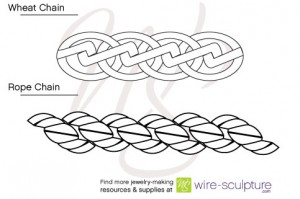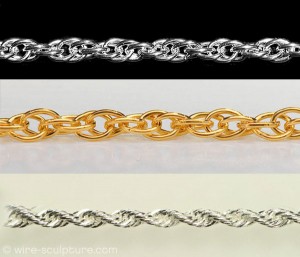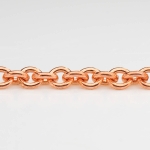- NEW DVD Series – Stone Setting with Bezels
- Tube Set Charm by Kim St. Jean
- Prong Basket Pendant by Kim St. Jean
- NEW DVD Series – Stone Setting with Cold Connections
- New DVD Series – Stone Setting with Wire
- NEW DVD Series: Introduction to Stone Setting by Kim St. Jean
- Featured Tool: Bracelet Bending Plier
- NEW Dvd by Eva Sherman
- Fun, Fast Fold Forming DVD Series
- Double Band Ear Cuff from Alex Simkin
About Jewelry Chain: Wheat Chain and Rope Chain
by Rose Marion, Wire-Sculpture.com
Wire Jewelry Idea for
October 24, 2012
What are Wheat Chain and Rope Chain?
Wheat chain and rope chain have the appearance that the links are braided or twisted together, rather than simply linked. Wheat chain is also found under the name spiga or espiga (Spanish for wheat) chain.
It seems that there are many ways of making a chain that looks like growing grains of wheat. Some vendors claim that their wheat chain is made from 4 woven strands of wire. Others say that wheat chain is formed of narrow, long tear-drop-shaped links. Another source says wheat chain uses oval and twisted (like curb chain is twisted) links that interconnect, and this seems to be the most common type of wheat chain. In general, wheat chain does not move as much as simpler chains like curb and rolo chain because the links are so narrow and hold so many other links, that movement is restricted.
Some people call wheat chain, spiga chain (espiga is the Spanish word for wheat). It seems when people refer to spiga chain, this chain is made of figure-8 links linked together, giving it an even more intricate, braided appearance than wheat chain.
Rope chains typically looks like two strands or coils of wire that have been twisted together, also called a double helix. This is a popular chain style for men’s jewelry, and it is usually quite thick. Some of the links may have flat sections, giving a faceted effect: this is called diamond-cut rope chain. The links are typically oval or round, and rather than being twisted or spiraled together, the links are carefully joined to the link across from them. This is a very delicate process, and even though automatic rope chain machines have been around since the 1930s, still today many of the rope chains on the market are handmade. Italy provides much of the world’s machine-made chain. For a detailed drawing of a rope chain, check out this PDF copy of a patent filed on fine jewelry rope chain.
Pictures of Rope Chain and Wheat Chain

Hint: You can click the above picture and right-click > Save to save it to your computer, or click on it and Print. There will be more diagrams coming!
Next week, we’ll talk about Viking Knit and I-Cord chain, which are fun to make with wire. See you then!
Resources & Further Reading
- List of Jewelry Chains
- Types of Gold Chain
- Jewellery Chain
- Free Patents Online – Rope Chain
- Spiga Wheat Chains
- About.com – Wheat Chain
- Machine Made Rope Chain
Have a Wire Jewelry Idea you’d like to share? Click Here to submit your idea. You could be featured on our Blog!
Click to Receive Daily Tips by Email





















Gail
October 24, 2012 at 6:08 am
These chains and the others that you have featured are beautiful. I would like to use the heavier, denser chains in my designs. How do you attach jumprings or clasps to these chains?
Rose
October 25, 2012 at 1:19 pm
Hi Gail, on chain that’s big enough to slide a jump ring through, that’s a good bet. Then you can attach a clasp to the jump ring.
On chain that’s too fine or dense to fit a jump ring through, look for crimp styles or caps that have “teeth” at the ends (the name escapes me now!) They look like an end cap but have little pieces of metal that will go into the chain if you put the finding over then end, and then squeeze with flat nose pliers. You could also try making a loop with fine wire (26-gauge) and covering that loop with a cone, like you would to finish Viking Knit weave. Me, I go for the pre-made finished chain!
renah
October 24, 2012 at 8:09 am
Last night I took a jewelry making class and learned a new-for me- chain technique. It was fascinating. First we crocheted the 24 guage wire and then braided the 3 strands we had done. It is very attractive with beads worked through it and i am wearing it proudly.
Mary Phillips
October 25, 2012 at 5:43 am
How do you end the more open type of rope chain. I have used but the end looks funky. Would a figure 8 link work do you think?
Pingback: About Jewelry Chain: Chain Reference Sheet | Jewelry Making Blog | Information | Education | Videos
David Plunkett
March 28, 2016 at 5:46 pm
Hello friends. I recently (past 2 years) taught myself lost wax casting, and clay casting by watching videos on youtube, and also a long hard road of trial and error, and hundreds of questions on the internet to every forum I could find relative to jewelry making. It was an enormous endeavor to say the least but today I am a full blown clay casting and lost wax casting studio selling my own items for awesome profit on eBay and other public venues.I make my own necklaces, rings, pendants and just about anything you can imagine. I have learned so much in such a short span of time and one of my problems is my enormous thirst for knowledge, and an overwhelming desire to try EVERY technique under the sun, and also travel every road that I can with respect to making jewelry and this has led me to my current desire in life. I want to learn how to make a tightly knit rope chain like the traditional stuff out there (men’s rope chains E.G.) I know they are mostly machine made but I want to make one hand made but I can not figure out how they attach the links. It looks as though they are c shaped links constantly wrapped side by side and never closed but rather pinched to their inner selves. Is there a good video or pictorial video or presentation anywhere that can show you how EXACTLY to make these chains? Or even a good book that illustrates clearly the technique? Many thanks and many thanks for your contributions to the jewelry trade.